Pond Life Digital Video Gallery
Freshwater ponds provide a home for a wide variety of aquatic and semi-aquatic plants, insects, and animals. The vast majority of pond inhabitants, however, are invisible until viewed under the microscope. Beneath the placid surface of any pond is a microscopic metropolis bustling with activity as tiny bizarre organisms pursue their lives; locomoting, eating, trying not to be eaten, excreting, and reproducing. In this collection of digital videos, observe the activities of microscopic organisms taken from a typical North Florida pond.
Annelids
Annelids are the phylum of segmented worms that includes earthworms, aquatic worms, leeches, and a large number of marine worms. There are over 9,000 species of annelids in the world.
-
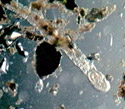
Aquatic Earthworm
As aquatic members of the class Oligochaeta in the phylum Annelida, aquatic earthworms are not an oxymoron, but rather relatively pollution-tolerant worms.
-
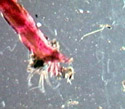
Tubifex
Commonly known as sewage worms, Tubifex tubifex is a true earthworm (class Oligochaeta), easily recognized by its red color and mud tubes.
Arachnids
The phylum Arachnida is a widespread and diverse group of arthropods, including forms such as scorpions, spiders, ticks, and mites. They are primarily terrestrial and have a segmented body and tough exoskeleton, four pairs of legs, no antennae, and two specialized pairs of appendages used for feeding.
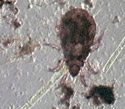
Oribatida
The water mites, a grouping of nine superfamilies and more than 40 families of Hydracarina worldwide, comprise more than 5,000 named species in the suborder Oribatida.
Cnidaria (Coelenterata)
In the phylum Cnidaria, the name is derived from the threads (or cnidae) contained in the stinging cells that are common to all members of the phylum. Colenterata is another name for the same phylum, but is used as a description for the internal gut (coelenteron) that is also featured on members of the phylum. The most prominent members of Cnidaria are the sea anemones, corals, jellyfish, sea pens, and hydra.
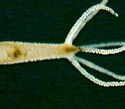
Hydra
In a phylum dominated by marine species, the hydra (class Hydrazoa) are among the few commonly observed coelenterates in freshwater ecosystems.
Crustaceans
These primarily aquatic arthropods occur in a wide variety of habitats, but most species live in the ocean. Crustaceans are one of the most successful groups of animals, as abundant in the oceans as insects are on land.
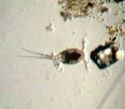
Cyclops
Recalling the mythological one-eyed giants of Homer's Odyssey, Cyclops are predominantly free-living crustaceans featuring a central, anterior eyespot.
Gastropoda
These primarily aquatic arthropods occur in a wide variety of habitats, but most species live in the ocean. Crustaceans are one of the most successful groups of animals, as abundant in the oceans as insects are on land.
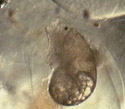
Aquatic Snail
Carrying their homes on their backs, snails are important in aquatic ecosystems, in which their grazing and scavenging of diatoms, algae and bacteria enhance nutrient recycling.
Insects
The widespread insect world is home to somewhere between one and ten million species, divided into 32 orders with the largest being the Beetles (Coleoptera). Insects are capable of inhabiting both wet and dry environments and are found in just about every part of the world. The average soil density of land-based insects is about 9 million per acre with about ten thousand "in flight" above it. Other insects live in or near ponds, streams, rivers, and lakes, where they feed and also breed.
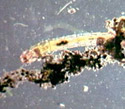
Chironomid
In addition to supporting the biomass of the freshwater fishes community, chironomids are essential in the diets of many migratory shorebirds and waterfowl.
Nematodes
The roundworms, or nematodes, are among the most abundant multicellular animals on Earth, many of which are parasitic to plants or animals. These transparent, microscopic worms in the phylum Nematoda include free-living forms found in aquatic and terrestrial ecosystems. There are 10,000 described species, but perhaps another 100,000 that deserve taxonomic status.
Protozoans
Protozoans are one-celled organisms belonging to the Kingdom Protista, which includes algae and lower fungi. Although they are invisible to the naked eye, they dominate the Earth's environment, occurring everywhere and in an amazing diversity of forms and functions.
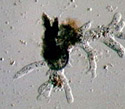
Amoeba
Amoebas are primitive, unicellular animals known by their flowing, free-form movements and their prey capture techniques.
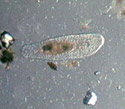
Spirostomum
Known for displaying the fastest contraction of any living cell, the relatively giant ciliates in the genus Spirostomum are the true speed demons of the microscopic world.
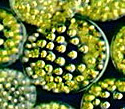
Volvox
Straddling the plant and animal kingdoms, the protist Volvox forms stunning bright green colonial balls in water bodies that are enriched in nitrates.
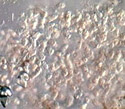
Vorticella
As a member of the phylum Cilophora (ciliates), Vorticella grow in macroscopic clusters of stalked individual animals that may be mistaken for a colony of filamentous algae.
Rotifers
The roundworms, or nematodes, are among the most abundant multicellular animals on Earth, many of which are parasitic to plants or animals. These transparent, microscopic worms in the phylum Nematoda include free-living forms found in aquatic and terrestrial ecosystems. There are 10,000 described species, but perhaps another 100,000 that deserve taxonomic status.
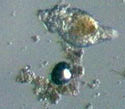
Collotheca
Rotifers in the genus Collotheca are sessile and may form spherical colonies or attach singly to the substrate or to submerged aquatic plants.
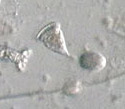
Philodina
Placed in the class Bdelloidea, which is Greek for leech, species in the genus Philodina possess two ovaries and are solely parthenogenetic.
